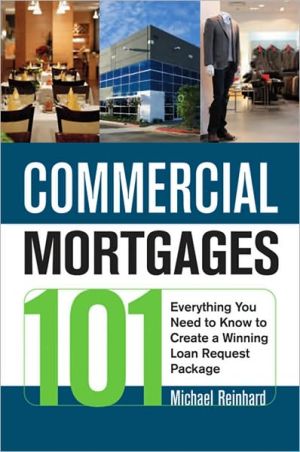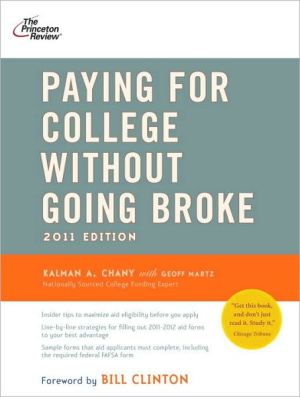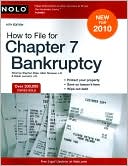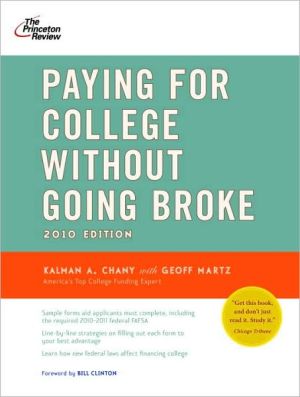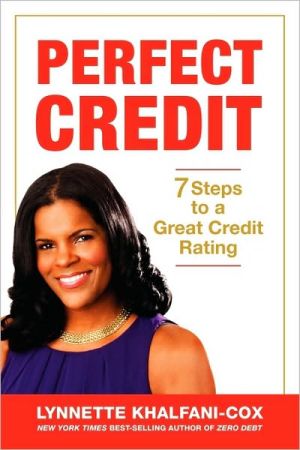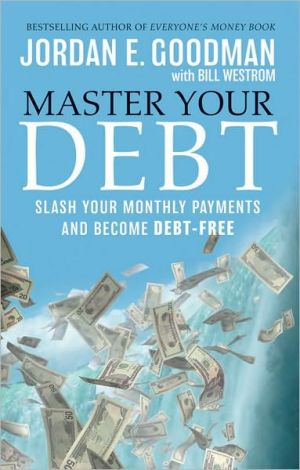Commercial Mortgages 101: Everything You Need to Know to Create a Winning Loan Request Package
With real estate prices at their lowest in years and the economy poised for a rebound, it’s an opportune time to invest in commercial real estate. But credit and financing issues can still pose challenges that prospective borrowers must overcome in order to get the money and mortgage terms they need.\ Commercial Mortgages 101 is a step-by-step guide for both real estate investors and mortgage brokers, offering insight, practical tools and a thorough overview of commercial mortgage...
Search in google:
Whether you’re a residential mortgage broker looking to break into the commercial mortgage brokerage business or a beginner real estate investor looking to transition from small residential properties to large commercial investment properties, learning how to think and speak like a commercial real estate lender will put you on an even playing field with the professionals. Commercial Mortgages 101 takes you step-by-step through the entire process of applying for a commercial real estate loan and putting together a professional loan request package. Clarifying common industry terms such as “debt-service-coverage-ratio” and “balloon payment,” and including a sample Real Estate Owned (REO) Schedule, this easy-to-follow beginner’s guide touches on all key aspects of what can all too often be a mystifying and confusing process. You’ll learn how to:• Correctly apply and use a variety of commercial mortgage terms and phrases. • Read and interpret a lender’s preliminary loan proposal. • Quickly size and underwrite a basic commercial real estate loan. • Prepare a persuasive and professional looking loan request package. • Identify the different types of non-income and income-producing commercial properties. • Prepare a personal cash flow statement and calculate your true net worth and liquidity. • Create and use the all-important Real Estate Owned (REO) Schedule. • Choose the right form of ownership, (including LP, LLC, co-tenancy and others).There’s never been a more opportune time to get involved in commercial real estate. Commercial Mortgages 101 gives you all the tools and information you need to put your best foot forward, secure the most favorable terms, and navigate the process like a pro.Michael Reinhard is an independent commercial mortgage banker for Texas Commercial Mortgage, which specializes in commercial real estate lending across the country. He has originated and underwritten over $300 million in commercial real estate loans since 1995 covering apartment buildings, retail centers, office buildings, industrial warehouses, and more.
INTRODUCTION Commercial Mortgages 101 is the culmination of fifteen years' experience in commercial real estate lending and credit analysis that began at the conclusion of the savings and loan crisis of the late 1980s and early 1990s. Toward the end of the savings and loan crisis that dominated the headlines for nearly a decade, commercial real estate lending was virtually nonexistent. Lending practices and underwriting policies once thought sound were now deemed completely unreliable. Eventually, a new breed of lenders rose from the ashes and reestablished the commercial real estate lending industry, transforming and setting in place new underwriting and credit standards still relevant today. Commercial Mortgages 101 embodies this new establishment and attempts to provide a comprehensive overview of commercial real estate loans and fundamentals in underwriting and credit analysis. But before we discuss the contents within this book, a little history is in order. The Tax Reform Act of 1986 and ensuing savings and loan crisis set in motion the beginning of the end for commercial real estate loans. Commercial real estate lenders were about to enter the Dark Ages, a decade-long systematic collapse and decline of the commercial real estate loan industry. From 1986 to 1995, the number of federally insured savings and loan institutions in the United States declined from 3,234 to 1,645. This was primarily but not exclusively a result of unsound commercial real estate lending. While they were not part of the savings and loan crisis, many other commercial banks failed during this time, as well. Between 1980 and 1994, more than 1,600 banks insured by the Federal Deposit Insurance Corporation (FDIC) were closed or received FDIC financial assistance. The U.S. government ultimately appropriated $105 billion to resolve the crisis. After banks repaid the loans through various government interventions, there was a net loss to taxpayers of approximately $124 billion by the end of 1999. Although the savings and loan crisis of the 1980s and early 1990s seemed to have singlehandedly brought the commercial real estate lending industry to a halt, there were a few commercial banks and nonbank lenders such as life insurance companies and pension fund advisors that were still making commercial real estate loans, primarily refinances. But it wasn't until about 1993 that a new breed of commercial real estate lenders called conduit lenders emerged as a new source of commercial real estate loans, marking the beginning of a new era and forever changing the way commercial real estate loans are originated and underwritten. Conduit lenders, which were created by Wall Street investment banks, reignited the commercial real estate loan industry by providing a secondary market (called securitization) for mortgage banking firms, commercial banks, life insurance companies, and federal savings banks (successors of the savings and loan banks), a market that had never before existed. The commercial real estate lending industry, unlike years before, was now back in business. With the advent of conduit lending or securitization came a new way of underwriting that was sorely absent during the era of the savings and loan turmoil. Stringent underwriting ratios and guidelines set by Wall Street investment banks during this time became the new standard for making commercial real estate loans among traditional banks or any other lender entering the mortgage banking business. Sound underwriting practices didn't just stop with the Wall Street banks; credit rating agencies such as Standard & Poor's, Fitch, and Moody's also provided further scrutiny before a loan was securitized. The adoption of this new underwriting standard by traditional banks and other nonconduit lenders has duly been cemented in the industry and now serves as the basis for understanding how commercial real estate loans are underwritten. The commercial real estate loan industry is ver
Acknowledgments xiIntroduction xiiiChapter 1 An Introduction to Commercial Real Estate Loans 1What Is a Commercial Mortgage? 2"Mortgage" Defined 3"Commercial" Defined 5Types of Commercial Properties 7Non-Income-Producing Properties 7Income-Producing Properties 9Single-Tenant Properties 10Multitenant Properties 11Types of Commercial Real Estate Lenders 14Banks 16Life Insurance Companies 18Conduit Lenders 19Agency Lenders 21Credit Companies 23Mortgage Bankers 24Private Lenders 25Commercial Mortgage Terms 25Maturity Period 26Amortization Period 27Loan-to-Value Ratios 28Interest Rates 29Prepayment Penalty 31Recourse vs. Nonrecourse Loans 33Commercial Mortgage Underwriting 33Sponsorship 34Property Underwriting 35Final Underwriting Analysis 43Chapter 2 Preparing the Loan Request Package 45Executive Summary 47Purpose of Loan Request 48Sources and Uses 52Property Description and Location 53Financial Summary 57Borrower 58Property Description 59Location and Demographics 61Property Economics 63Financial Statements 64Financial Analysis 65Schedule of Income 67Historical Cash Flow 72Loan Analysis 74Supporting Documents 80Market and Submarket Data 81Sponsorship 84Chapter 3 Financial Strength and Creditworthiness 87Net Worth and Liquidity 88Assets 89Non-Real Estate Assets 91Real Estate Assets, Cash Equity, and Market Equity 93Cost vs. Market Value 96Pre-Funding Liquidity 97Post-Funding Liquidity 99Lender's Calculation of Net Worth and Pre-Funding and Post-Funding Liquidity 101Credit Score and History 108Five Adverse Conditions Unacceptable to Commercial Lender 110Personal Income and Cash Flow 116Gross Income 117Self-Employment Income 119Net Cash Flow and Taxable Net Cash Flow from Rental Income 120Cash Flow Statement 124Banking and Credit References 126Chapter 4 Real Estate Experience 129Ownership and Management Experience 130Ownership Experience 130Management Experience 133Chapter 5 Real Estate Assets 143The REO Schedule 144The REO Schedule and the Balance Sheet 145Anatomy of an REO Schedule 151Property Value Section 155Property Name 156Property Description 157Property Address 157Date of Acquisition 158Original Cost of the Property 158Name and Address of Lender 159Loan Number 159Ownership Percentage 160Market Value of the Property 160Balance of Mortgages 163Total Equity 164Net Ownership Equity 165Cash Flow Section 166Monthly Rental Income 167Monthly Operating Expenses 170Monthly Loan Payments 172Monthly Cash Flow 173Net Ownership Cash Flow 174Chapter 6 Forms of Ownership 177Borrowers and Borrowing Entities 178Types of Borrowers and Borrowing Entities 181Individual Ownership 182Co-Tenancy and Joint Ownership 184Partnerships 188Limited Liability Companies 195Corporations 197Trusts 200Index 203
\ From the Publisher"a useful tool for the business person looking to get into the commercial real estate space while prices are cheap" --Houston Business Journal\ \ \
